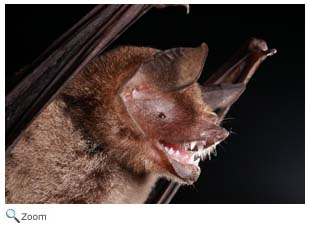Mormoopidae - ghost-faced bats, mustached bats
 There are nine species in this family of small to medium-sized bats. They are found in from the southern United States south to South America. There are nine species in this family of small to medium-sized bats. They are found in from the southern United States south to South America.
They have no nose leaves but large lip leaves. They have tails and bristly hair on their muzzles. They range in color and can be brown, orange-brown, black, reddish-brown, or yellowish-brown. They eat flying insects and live in colonies in caves.
Species in this order include:
the ghost-faced bat, Antillean ghost-faced bat,
Parnell's mustached bat,
big naked-backed bat,
Davy's naked-backed bat, and the
sooty mustached bat.
World Status Key
 Least Concern Least Concern  Near Threatened Near Threatened  Vulnerable Vulnerable  Endangered Endangered  Critically Endangered Critically Endangered  Extinct in Wild Extinct in Wild  Extinct Extinct
Status and range is taken from ICUN Redlist. If no status is listed, there is not enough data to establish status.
US Status Key
 Threatened in US Threatened in US  Threatened in NH Threatened in NH  Endangered in US Endangered in US  Endangered in NH Endangered in NH  Introduced Introduced
Status taken from US Fish and Wildlife and NH Fish and Game
Additional Information
Key:  Profile Profile  Photos Photos  Video Video  Audio Audio
Ghost-faced Bat - Mormoops megalophylla     
The Ghost-face bat is found from southern Arizona and Texas south through Mexico and into northwestern Peru and northern Venezuela.
Source: Animal Diversity Web Intended Audience: General Reading Level: Middle School
Ghost-faced Bat - Mormoops megalophylla     
The ghost-face bat roosts in colonies in caves, crevices, and abandoned mine tunnels.
Source: Mammals of Texas Intended Audience:General Reading Level: Middle School
Parnell's Mustached Bat - Pteronotus parnellii   
Parnell's mustached bat is found in Belize, Bolivia, Brazil, Colombia, Costa Rica, Cuba, the Dominican Republic, El Salvador, French Guiana, Guatemala, Guyana, Haiti, Honduras, Jamaica, Mexico, Nicaragua, Panama, Peru, Puerto Rico, Saint Vincent and the Grenadines, Suriname, Trinidad and Tobago, and Venezuela.
Source: Animal Diversity Web Intended Audience:General Reading Level: Middle School |
|

